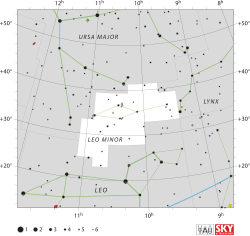11 Leonis Minoris
11 Leonis Minoris, som är stjärnans Flamsteed-beteckning, är en dubbelstjärna,[2] belägen i den södra delen av stjärnbilden Lilla lejonet. Den har en kombinerad skenbar magnitud av ca 5,54[2] och är svagt synlig för blotta ögat där ljusföroreningar ej förekommer. Baserat på parallax enligt Gaia Data Release 2 på ca 89,2[1] mas, beräknas den befinna sig på ett avstånd på ca 37 ljusår (ca 11 parsek) från solen. Den rör sig bort från solen med en heliocentrisk radialhastighet på ca 14 km/s,[6] har en relativt stor egenrörelse och rör sig över himlavalvet med en vinkelhastighet av 0,764 bågsekunder per år.[12]
| 11 Leonis Minoris | |
 | |
| Observationsdata Epok: J2000.0 | |
|---|---|
| Stjärnbild | Lilla lejonet |
| Rektascension | 09t 35m 39,50181s[1] |
| Deklination | +35° 48′ 36,4841″[1] |
| Skenbar magnitud () | +5,54 + 14,0 (V)[2] |
| Stjärntyp | |
| Spektraltyp | G8 V[3] + M4[4] |
| U–B | +0,44 |
| B–V | +0,77[5] |
| Variabeltyp | RS Canum Venaticorum-variabel[6] |
| Astrometri | |
| Radialhastighet () | +14,40[6] km/s |
| Egenrörelse (µ) | RA: -726,201[1] mas/år Dek.: -259,506[1] mas/år |
| Parallax () | 89,2581 ± 0,1928[1] |
| Avstånd | 37,08[5] lå (11,37[5] pc) |
| Absolut magnitud () | 5,25 ± 0,008[7] |
| Detaljer | |
| Massa | 0,964[8] / 0,23[9] M☉ |
| Radie | 1,0029 ± 0,0158[8] R☉ |
| Luminositet | 0,7550 ± 0,0055[8] L☉ |
| Temperatur | 5 376 ± 43[8] K |
| Metallicitet | +0,33[10] dex |
| Ålder | 7,9[8] miljarder år |
| Andra beteckningar | |
| 11 Lmi, AG+36 941, AKARI-IRC-V1 J0935390+354835, BD+36 1979, CCDM J09357+3549A, EUVE J0935+35.8, GJ 356 A, GSC 02500-01533, HD 82885, HIC 47080, HIP 47080, HR 3815, IRAS 09326+3602, LHS 2156, LSPM J0935+3548, 2MASS J09353959+3548366, NLTT 22117, PLX 2280, PPM 74631, 1RXS J093540.6+354902, SAO 61586, TYC 2500-1533-1, USNO-B1.0 1258-00174944, uvby98 100082885 ABV, V* SV LMi, WDS J09357+3549A, WISEA J093538.92+354834.4, Gaia DR2 798068905726303232 [11] | |
Egenskaper
redigeraPrimärstjärnan 11 Leonis Minoris A är en gul till vit stjärna i huvudserien av spektralklass G8 V.[3] Den har en massa och en radie som är ungefär lika med solens[8] och utsänder från dess fotosfär ca 75 procent[8] energi av vad solen gör vid en effektiv temperatur av ca 5 400[8] K. Jämfört med solen har den mer än dubbelt överskott av element som är tyngre än helium, vilket utgör stjärnans metallicitet.[10]
11 Leonis Minoris är en RS Canum Venaticorum-variabel med en variation i magnitud med 0,033 enheter[6] med en period av 18 dygn.[13]
Följeslagaren 11 Leonis Minoris B är en röd stjärna av 14:e[2] magnituden och mycket mörkare än primärstjärnan. Paret har en omloppsperiod på 201 år med en hög excentricitet på 0,88.[3]
Se även
redigeraReferenser
redigera- Den här artikeln är helt eller delvis baserad på material från engelskspråkiga Wikipedia, 11 Leonis Minoris, 21 april 2020.
Noter
redigera- ^ [a b c d e f] Brown, A. G. A.; et al. (Gaia collaboration) (August 2018). "Gaia Data Release 2: Summary of the contents and survey properties". Astronomy & Astrophysics. 616. A1. arXiv:1804.09365. Bibcode:2018A&A...616A...1G. doi:10.1051/0004-6361/201833051. Gaia DR2 record for this source at VizieR.
- ^ [a b c d] Eggleton, P. P.; Tokovinin, A. A. (September 2008), "A catalogue of multiplicity among bright stellar systems", Monthly Notices of the Royal Astronomical Society, 389 (2): 869–879, arXiv:0806.2878, Bibcode:2008MNRAS.389..869E, doi:10.1111/j.1365-2966.2008.13596.x.
- ^ [a b c] Malkov, O. Yu.; et al. (2012), "Dynamical masses of a selected sample of orbital binaries", Astronomy & Astrophysics, 546: 5, Bibcode:2012A&A...546A..69M, doi:10.1051/0004-6361/201219774, A69
- ^ Reid, I. Neill; et al. (July 2004), "Meeting the Cool Neighbors. VIII. A Preliminary 20 Parsec Census from the NLTT Catalogue", The Astronomical Journal, 128 (1): 463–483, arXiv:astro-ph/0404061, Bibcode:2004AJ....128..463R, doi:10.1086/421374
- ^ [a b c] https://www.universeguide.com/star/11leonisminoris. Hämtad 2020-04-21.
- ^ [a b c d] Soubiran, C.; et al. (2008), "Vertical distribution of Galactic disk stars. IV. AMR and AVR from clump giants", Astronomy and Astrophysics, 480 (1): 91–101, arXiv:0712.1370, Bibcode:2008A&A...480...91S, doi:10.1051/0004-6361:20078788
- ^ Park, Sunkyung; et al. (2013), "Wilson-Bappu Effect: Extended to Surface Gravity", The Astronomical Journal, 146 (4): 73, arXiv:1307.0592, Bibcode:2013AJ....146...73P, doi:10.1088/0004-6256/146/4/73.
- ^ [a b c d e f g h] Boyajian, Tabetha S.; et al. (July 2013), "Stellar Diameters and Temperatures. III. Main-sequence A, F, G, and K Stars: Additional High-precision Measurements and Empirical Relations", The Astrophysical Journal, 771 (1): 40, arXiv:1306.2974, Bibcode:2013ApJ...771...40B, doi:10.1088/0004-637X/771/1/40.
- ^ Tokovinin, Andrei (April 2014), "From Binaries to Multiples. II. Hierarchical Multiplicity of F and G Dwarfs", The Astronomical Journal, 147 (4): 14, arXiv:1401.6827, Bibcode:2014AJ....147...87T, doi:10.1088/0004-6256/147/4/87, 87.
- ^ [a b] Maldonado, J.; et al. (October 2010), "A spectroscopy study of nearby late-type stars, possible members of stellar kinematic groups", Astronomy and Astrophysics, 521: A12, arXiv:1007.1132, Bibcode:2010A&A...521A..12M, doi:10.1051/0004-6361/201014948
- ^ "* 11 LMi". SIMBAD. Centre de données astronomiques de Strasbourg. Hämtad 2020-04-21.
- ^ Lépine, Sébastien; Shara, Michael M. (March 2005), "A Catalog of Northern Stars with Annual Proper Motions Larger than 0.15" (LSPM-NORTH Catalog)", The Astronomical Journal, 129 (3): 1483–1522, arXiv:astro-ph/0412070, Bibcode:2005AJ....129.1483L, doi:10.1086/427854.
- ^ Skiff, B. A.; et al. (March 1986), "The photometric variability of solar-type stars. V - The standard stars 10 and 11 Leonis Minoris", Publications of the Astronomical Society of the Pacific, 98: 338–341, Bibcode:1986PASP...98..338S, doi:10.1086/131763



